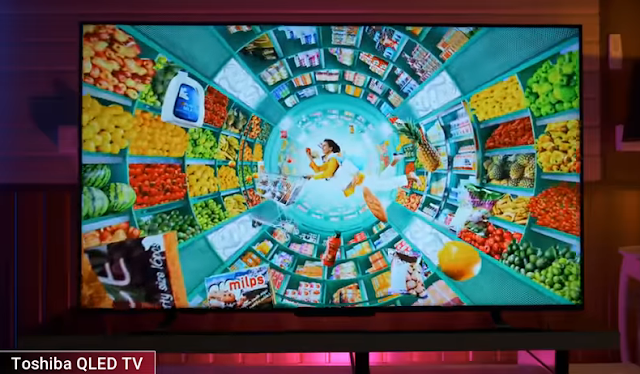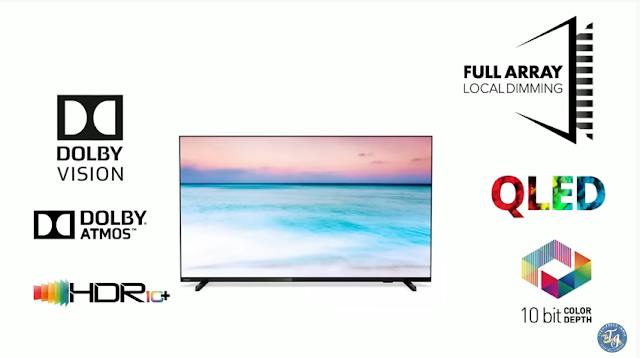Budget companies are doing aggressive marketing by luring customers with high-end specifications, found in costly TVs, but, honestly speaking, most of the features present on budget TVs should be seen as more of a marketing gimmickry! Nowadays, budget companies claim 10-bit panels on their TVs, which is wrong.
In the budget category, none of the TVs come with the real 10-bit panels, all, have either 8-bit or 8-bit dithering panels.
An 8-bit dithering panel is the one that tries to imitate
the 10-bit real panel, but it fails in doing so.
This is the reason why you get to see banding even in these
so-called 10-bit panels.
Banding is unwanted horizontal lines of solid colours that
are seen on TVs.
Banding takes place when a TV has a problem forming the
right shades of different colours.
For example, if there is footage of a sky and the light blue
sky is turning dark blue on the upper side, then, on an 8-bit or 8-bit
dithering panel, you might not see a smooth transition.
At the meeting point of these two shades, you will see
banding, which spoils the viewing experience as I pointed out on the Toshiba
QLED TV.
On some TVs, there might be a problem related to Blue and
Grey colour shades, whereas, others can have a problem making other colour
shades.
On a real 10-bit panel TV, you will always see a smooth transition between different colour shades.
There is no use of a wide colour gamut on a TV, whose panel
is not efficient enough to handle those billion colours.
Every LED TV combines Blue, Green and Red light in different
proportions to produce colours! Banding depends on the colour proportion used
by the TV.
In many TVs, the main problem arises from the fact that the
source material produces billions of colors, which the panel is unable to
handle.
This is the reason why multiple pixels get accumulated on
the TV screen in form of solid colour strips.
Though the company sell their TVs highlighting a wide colour
gamut in specifications, the panel of these TVs are not efficient enough to
handle those billion colours.
So, next time, don't get excited, just by looking at the
wide colour gamut specification in the TV details.
You need to know that you can never get a TV in the budget
category that will perform at par with the costly TVs of Sony, Samsung and LG.
You just need to search for the best TV in your budget that
gives the best value for your money.
The Mi OLED TV stands nowhere even close to the costly OLED
TVs from LG and Sony.
The real thing is that the budget companies catching the
nerve of the middle-class, though, have brought forth their budget QLEDs and
OLEDs TVs, in the market, the performance of these TVs is nowhere even close to
the real QLED and OLED TVs.
Honestly speaking, the term QLED can hardly be justified, when
it comes to the QLED TVs falling in the budget category.
The colours of budget QLED TVs hardly go beyond that of a
simple 4k TV.
I have observed that most of the QLED TVs, whether they are
from Motorola, Nokia or Toshiba, display inferior HDR performance than their
simple 4k TVs.
So, the desire of buying a budget QLED TV might land you into trouble when neither you get enhanced colours, nor any good HDR performance! When in my review, I describe the colours of any budget QLED as natural, then you should be able to understand that the TV doesn't have vibrant colours like any Samsung QLED TV, and, its colour reproduction is just like any other 4k TV! The main difference between normal 4k TVs and QLED TVs is the vibrancy in the colours and if any QLED TV is displaying natural colours, what is the logic behind spending more on it? In my upcoming videos, I will tell you about the best QLED TVs and will also elaborate on why they are better than the other budget QLEDs.
Full Array Local Dimming hardly plays any major role in
budget TVs.
Though budget companies hike the price of their TVs in name
of a Full Array Local Dimming, the desired effect of local dimming is hardly
seen in these TVs.
The performance of a Full Array Local Dimming TV depends on
the algorithm of the zones present, as to how they disperse forward the
backlight.
On the Toshiba QLED TV, I had shown you that the light on
the TV was not uniform. On the edges, the brightness was very low. On a good
TV, you will not find such brightness disparity.
Some difference is there, but, this vast difference in
brightness indicates that the TV was unable to disperse the light of the LEDs,
uniformly, all across the screen.
The performance of a FALD TV not only depends upon the count
of its dimming zones, but it also depends on the algorithm of those zones.
Ideally, you get the best performance of a FALD TV when it
has 400 or more dimming zones with a superior algorithm.
If any higher brand TV with lesser zones performs better
than any budget TV having much more zones, it means its zones come with a
superior algorithm.
Many people ask me whether they should buy a 4k or only an
FHD TV for viewing set-top box content.
Here, I would like to tell them that if you know that you
will be watching only set-top box content or utmost full HD content on YouTube,
Hotstar, Zee5, Amazon Prime and Sony Live, then don't buy a 4k TV, because the
channels of any set-top box and FHD content look much better on an FHD TV than
on any 4k TV.
Another important thing that you need to remember is never
to buy a demo unit! The life of a TV depends largely on its LEDs and when a TV
gets displayed day and night in a showroom, its life reduces drastically.
Even if you get a 3 years warranty, then too, in my opinion,
it is not a prudent deal.
The TV will go out of order every now and then, and after 3
years even that service support will be withdrawn, and then you have to spend a
lot of money on it.
So, don't take this risk just to save a little money.
Another thing, towards which I want to draw your attention,
is that till the time there was a huge difference between the prices of the
higher brand TVs and the budget brands, buying a budget TV was right.
Not only did you save your money, in this process, but at a lower price, you could buy a bigger screen, but now, when the difference is marginalized, if the performance of the budget TV is not much better than the higher brand TV of the same size, then going for a higher brand TV would be a better decision as higher brands have a much better aftersale service support.
The aftersales services of most budget brands are not good,
so you might face problems in future.
In the end, my suggestion to you is that don't buy old
models , especially when it comes to Sony, because when a TV gets discontinued
the supply of its parts falls gradually, and, by the end of 5 years, you don't
get any support for its parts.











Post a Comment
Post a Comment